A power supply is an electrical device that converts the electric current that comes from a power source to the voltage value necessary for powering a load, like a motor or an electronic device. There are two main designs for power supplies: a linear power supply and a switching power supply.
Linear: A linear power supply designs use a transformer to step down the input voltage. Then the voltage is rectified and turned into a direct current voltage, which is then filtered to improve the waveform quality. Linear power supplies use linear regulators to maintain a constant voltage at the output. These linear regulators dissipate any extra energy in the form of heat.
Switching: A switching power supply design is a newer methodology developed to solve many of the problems associated with linear power supply design, including transformer size and voltage regulation. In switching power supply designs, the input voltage is no longer reduced; instead, it’s rectified and filtered at the input. Then the voltage goes through a chopper, which converts it into a high-frequency pulse train. Before the voltage reaches the output, it’s filtered and rectified once again.
The principles of switched-mode conversion apply for both AC-DC and DC-DC power supplies. In the case of an AC-DC power supply, there are a couple of stages, including rectification of a single-phase 230Vac or 3-phase 400Vac 50Hz mains voltage, before the DC-DC conversion stages.
In both cases, in a DC-DC conversion stage, a primary circuit of power semiconductors (a power switch circuit) generates a high frequency alternating voltage to a transformer. This causes a current in the primary windings that will induce an alternating current in the secondary windings, so a secondary voltage is built up. The winding ratio of the transformer specifies stepping up or down. A secondary circuit rectifies the high frequency voltage and could create a feedback signal to the primary electronics for regulation.

For many years, linear AC/DC power supplies have been transforming AC power from the utility grid into DC voltage for running home appliances or lighting. The need for smaller supplies for high-power applications means linear power supplies have become relegated to specific industrial and medical uses, where they are still needed because of their low noise. But switching power supplies have taken over because they are smaller, more efficient, and are capable of handling high power.
When selecting an AC/DC switched-mode power supply, in addition to the required electrical specifications such as input and output voltage, power handling, and operating efficiency, there are several other factors on the product’s datasheet to investigate.
What is the line regulation? Most switch mode power suppliers regulate their output voltage to within +/- 3% of the stated nominal output. Is that sufficient for your end product? Also, is this maintained across all load conditions, from, say 10% load to 100 % load?
Does it have a peak output or boost capability? This useful feature permits drawing, for example, 150% of full load for a short duration. A motor start-up can benefit from this, allowing the selection of a lower-rated, cheaper power supply than having to accommodate the full peak load with a more expensive power supply.
Don't forget to make sure that the power supply meets all relevant international and country-specific regulations for energy efficiency, safety, and electromagnetic interference. Standards stipulate the minimum levels of energy efficiency at full load and 10% load, together with the maximum energy consumption during no-load conditions. In the United States the relevant standard is DoE Level VI, and in Europe, the EcoDesign 2019/1782.
Generic safety regulations include IEC 62368-1 for IT and AV equipment and, if you have a medical product, IEC 60601-1. For electric household products there is the IEC 60335-1 directive.
Additional directives include particular requirements for LED lighting, HVAC and other applications. EMI standards CISPR32 and FCC20870 stipulate the requirements of electromagnetic interference and susceptibility.
Shenzhen Super Dragon Technology Co.,Ltd. was founded in March 2008 and is known for its efficient management team and an experienced R&D and process development team.
Power supply business is a division integrating R&D/production/sales/customer service. We mainly provide customer a few series of eco-friendly adapter, charger, smart fast charger, power converter module for telecomm and so on. We have a professional R&D team and talents are gathered in production, engineering, quality team too. Relay on the strong ability of development, manufacture and quality control , we can provide eco-friendly and price competitive products to consumer along with high quality. If you have more questions, please do not hesitate to contact us.